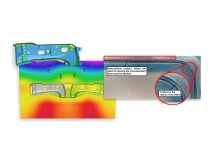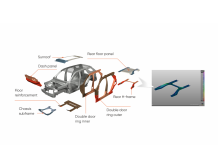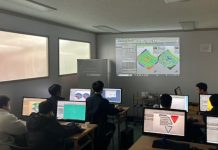A recurring theme on this blog, so far, has been sources of variation in production that might not be apparent to engineers when defining, running, and evaluating a single simulation on any specific product/process design. Comments on the blog and on social media have pointed out that there are still many other sources of potential variation, or noise, in the production environment besides the already mentioned material properties and drawbead conditions. This post is one in a series that will try to further expand the list of potential production noise variants to consider.
First, consider that the forming system is comprised of basic elements:
- the incoming material stock (coil and/or blanks)
- the stamping production line and environment
- the die itself

Coil characteristics and the blanks taken from the coil are a common source of variation in stamping

The resulting quality of any stamped part is governed by the combination of these elements. The effect of these different inputs and any variation in parameters can cause seemingly good production parts to “suddenly” fail—different coil leads to splits, or springback is worse after lunch break, or wrinkles always develop when it is raining. Changes to the incoming material, production environment, or tool can alter the production performance in ways not anticipated in the ideal engineering state assumed during the engineering phase.
The purpose of formability analysis is to try to determine what parameters deliver the most beneficial results in our stamping production processes. But if we fail to consider that the production environment does not automatically achieve the design intent, we risk sacrificing all the gains promised by formability engineering.

Thinning -thickness strain- is a valuable output measurement of the stamping system
In this blog we have so far pointed out a few of these key input parameters and will continue to expand on discussions of the influence that these variables have on stamping processes. Here is a short list of just a few variables worth mentioning.
| Blank/Coil | Production Line | Die |
| Thickness | Applied ram tonnage | Tooling radii (design intent vs. maintenance) |
| Yield and tensile strengths | Ram speed | Die surface and coating |
| Coil width and pitch | Applied cushion tonnage | Drawbead geometry (if any) |
| n-value and R-value | Shut height settings | Pad/binder spotting |
| Coating (if any) | Lubrication (if any) | Tool and surface condition |
| Mill oil | Cushion pin placement | In-die pressure systems |
| Edge condition of blanks | Parallelism and maintenance | Equalizer blocks or lack of |
| Weld line/patch weld/tailored thickness | Drive type | Tooling parallelism |
| Grain and rolling direction | Automation feed rate | Temperature |
| Substrate metallurgy | Blank/coil alignment to die | Location on bolster/ram |
| … and probably more | … and probably more | … and probably more |
Many of the above represent entire categories of parameters as well, further complicating an already expansive list of potential suspects when trying to identify how to improve a stamping process or design.

Springback is another output measurement for the stamping system
We will continue to expand our discussion of these variation drivers in future posts. Are there any you think we should add to the list, perhaps because they are a priority for you to understand in the near future? Please comment below. We look forward to hearing from you.














[…] springback deviation from design intent. This challenge is further frustrating as the engineering inputs often vary from tryout and production conditions, making the compensation applied to tooling produce […]
[…] our previous post on the stamping system, several environmental variables within production sheet metal stamping are mentioned. In that post […]
[…] our previous post on the stamping system, several environmental variables within production sheet metal stamping are mentioned. In that post […]